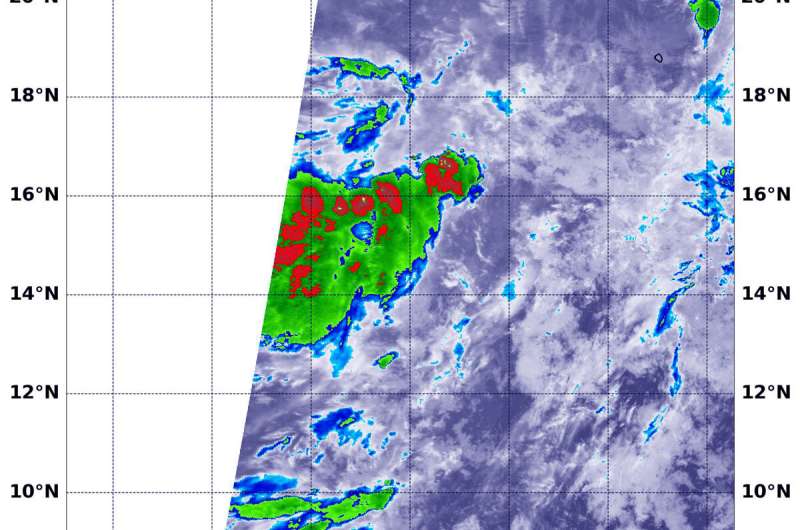On July 22 at 4:50 a.m. EDT (0850 UTC) the MODIS instrument that flies aboard NASA's Aqua satellite showed strongest storms in Tropical Depression 5# were south of the elongated center where cloud top temperatures were as cold as minus 70 degrees Fahrenheit (red) (minus 56.6 Celsius). Credit: NASA/NRL
A new tropical depression formed in the Eastern Pacific Ocean, far enough away from the coast so that no coastal warnings are needed. Infrared imagery from NASA's Aqua satellite shows that Tropical Depression 5E's strongest storms were southwest of its center of circulation because of outside winds.
NASA's Aqua satellite used infrared light to analyze the strength of storms and found the bulk of them in the southern quadrant. Infrared data provides temperature information, and the strongest thunderstorms that reach high into the atmosphere have the coldest cloud top temperatures.
On July 22 at 4:50 a.m. EDT (0850 UTC), the Moderate Imaging Spectroradiometer or MODIS instrument that flies aboard NASA's Aqua satellite gathered infrared data on Tropical Depression 5E. Strongest thunderstorms had cloud top temperatures as cold as minus 70 degrees Fahrenheit (minus 56.6 Celsius). Cloud top temperatures that cold indicate strong storms with the potential to generate heavy rainfall. Those strongest storms were southwest of the center of circulation because of vertical wind shear (winds blowing at different speeds at different levels of the atmosphere). The National Hurricane Center noted, "It appears that northeasterly shear is keeping much of the convection displaced to the west of the center of circulation."
At 11 a.m. EDT (1500 UTC) on July 22, the National Hurricane Center (NHC) said the center of Tropical Depression Five-E was located near latitude 15.9 degrees North and longitude 116.3 degrees west. That's about 640 miles (1.025 km) southwest of the southern tip of Baja California, Mexico.
The depression is moving toward the north near 9 mph (15 kph) and this motion is expected to continue for the next day or so, with a gradual turn to the northwest by midweek. Maximum sustained winds are near 35 mph (55 kph) with higher gusts. The estimated minimum central pressure is 1006 millibars.
NHC noted "Although convection [and thunderstorm development] has increased this morning, ] the [wind[shear is preventing the inner core of the depression from becoming better established." Some slight strengthening is possible over the next couple of days, and the depression is expected to become a tropical storm later today or tonight.
Provided by NASA's Goddard Space Flight Center
























